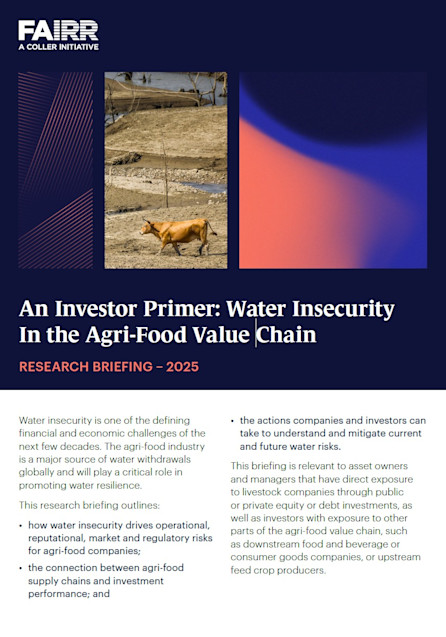Overview
Water insecurity is one of the defining financial and economic challenges of the next few decades. The agri-food sector is a major source of water withdrawals globally and will play a critical role in promoting water resilience.
This research briefing aims to help asset managers and owners understand:
how water insecurity drives operational, reputational, market and regulatory risks for agri-food companies;
the connection between agri-food supply chains and investment performance; and
the actions that can be taken to mitigate current and future water risks.
There is no clear consensus on the financial value of water, but water insecurity and stress caused by unsustainable water withdrawals could lead to higher operating costs, supply chain disruptions and stranded assets for livestock companies and the broader agri-food value chain, thereby decreasing shareholder returns and increasing the cost of capital.
The intensity of these risks will vary, depending on geography, protein type and supply chain complexity, as will the cost of addressing them. While the costs of water insecurity are under-researched and uncertain, given the agri-food industry’s dependence on water, they could be significant, especially if left unaddressed.
Conversely, companies that take a proactive approach to addressing water insecurity may see that reflected in their valuations, as water resilience can drive sustainable future value.
Addressing and mitigating water insecurity is challenging for companies, while it is difficult for investors to understand their exposure to these risks, due to disclosure gaps across supply chains, a lack of comparable company metrics, and insufficient targets to accelerate water-resilient business models.
Key highlights
Key findings from this briefing:
Water insecurity will intensify in future, as rising demand and climate change strain the availability of clean and accessible water.
The agri-food sector is particularly vulnerable to the challenges of water insecurity, given its dependence on freshwater.
There are significant gaps in the availability of robust water data and comprehensive disclosures.
Such limitations make it difficult for investors to meaningfully assess company-level exposure and financial risks, and to track progress against targets.
Addressing water insecurity requires comparable, decision-useful data specific to supply chains.
Investors can work with companies to understand and compare exposure to water insecurity, track water withdrawals across supply chains, and develop strategies to build water resilience.

